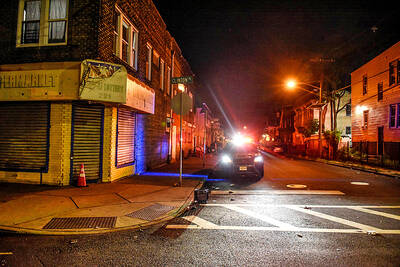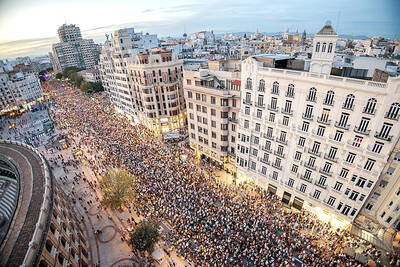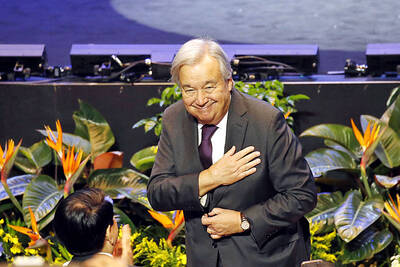It looks like a meteor strike: From out of nowhere, a huge clearing appears in the jungle — a deep rust-colored pit surrounded by mounds of dirt and thick stands of trees pushed to the side in dense piles of overturned soil.
However, this is no act of nature. It is the result of the steady labor of fewer than a dozen barefoot men, who have blasted away at the earth for three days with high-pressure water hoses and earth-movers, searching for gold and destroying a swathe of rainforest.
The miners near a small town called Nieuw Koffiekamp, at the edge of Suriname’s vast rainforest hinterland, planned to spend a week tearing into the soil and filtering it through toxic mercury. Then, they will start over again somewhere else.
Juergen Plein, a 29-year-old miner, said he needs the work and doesn’t know any other way to get at the precious metal.
“I think about it,” Plein, nearly shouting over the roar of generators, said of the damage. “But survival comes first.”
Thanks to record gold prices, hundreds of small-scale mining operations are proliferating along the northeastern shoulder of South America. Small-scale miners produced a record of nearly 16.5 tonnes of gold last year, according to Suriname’s government.
Miners are tearing up trees, poisoning creeks with mercury and, in some places, erecting makeshift jungle towns with shops, prostitutes and churches. In their wake is a wasteland, said Dominiek Plouvier, regional representative of the WWF.
“All the top soil has been removed, it’s finished,” Plouvier said. “This ecosystem is very fragile. It is very difficult to get it back in these areas.”
The miners, many of them illegal migrants from Brazil, are scattered throughout the northern Amazon basin, occasionally fleeing crackdowns by police or the military in Venezuela, French Guiana and Guyana. However, nothing seems to stop them in Suriname, a country rich in resources with the weakest law enforcement in the region.
The new government that took power this month is expected to at least attempt to address the issue. Vice President Robert Ameerali said they would seek to reduce the use of mercury, which is illegal but widely available to miners who use it to separate gold from ore.
Mining consultant Chris Healy said Suriname should set aside areas for small-scale miners and regulate their activities, providing training and assistance to acquire less-polluting technology.
“You can make all kinds of laws and enforcement,” he said. “But there is nobody there to enforce it.”
An estimated 14,000 small-scale miners and service providers work in Suriname’s interior, said Marieke Heemskerk, a consultant and anthropologist who has tracked mining in the country for years. The rampant and unrestricted subletting of mine concessions is illegal, but it’s largely tolerated by the government — and it gives people work.
Mining is a touchy subject in Suriname, which has gained praise over the years from environmentalists for placing limits on logging and setting aside large rainforest preserves. The metal, shipped to refiners in North America and Europe, is one of the main exports in a largely poor country of nearly 500,000 people that is about the size of Georgia. It is an important source of income, particularly for Maroons, the descendants of runaway slaves, and Amerindians in the interior, who make money providing transportation or selling access to their land concessions.
In recent years, small-scale miners have grown more destructive as they use more heavy equipment such as earthmovers — flown into remote spots in the jungle or shipped down rivers — to work faster or in more remote, larger areas.
In a country with few real roads, it is difficult to find the mines, but from the air it’s a different story.
Satellite analysis of the scarred earth and diverted waterways shows that miners in Suriname have deforested at least 30,000 hectares and damaged more than 2,200km of river over the past decade, Plouvier said. WWF estimates the small-scale mining is also responsible for some 20 tonnes of mercury entering the environment and posing a risk to people through fish consumption.
Some parts of Suriname have become like the Wild West, only with all-terrain-vehicles and satellite dishes.
Journalists visited a mining area about 160km south of the capital Paramaribo, reachable only by boat, followed by a bone-jarring ATV ride through the dense jungle.
All around were the huge telltale piles of discarded soil and open pits. In the middle of a network of trails was a town of sorts.
The one-street settlement — more of an outpost in the jungle — was a dusty clearing and a line of simple, plywood structures. There were two markets, two churches and four bars, festooned with small Brazilian flags. In the lull of a rainy afternoon, bored prostitutes sat watching TV until the customers returned. Plastic bottles, beer cans and other trash was strewn about everywhere or smoldering in burning piles.
Ines Aboikonbie, who runs a bar with her Brazilian husband, said the settlement of about 200 would probably move soon along with the miners in search of gold.
The largest gold mine in the country, at Rosebel not far from Nieuw Koffiekamp, is run by Toronto-based IAMGOLD Corp and employs 1,100 people. The mine produced nearly 12 metric tonnes of gold last year, but while all mining draws critics, environmentalists are more worried about the damage done by small operators over a wide expanse.
IAMGOLD spokesman Bob Tait said many people — including several hundred it accuses of illegally mining on its concession — prefer the informal sector because they like the flexibility and dream of finding riches.
“Sometimes it’s hard for us to compete,” he said.
Plein, the miner at Nieuw KoffieKamp, is a thin man with a scraggly beard and dreadlocks pulled back behind his head. He said the amount his crew earns depends on how much gold they find and how much fuel they use trying to find it — they might gross US$40,000 before paying for the equipment rental and dividing the proceeds.
One of the biggest challenges, he said, is finding a place to search amid fierce competition and competing claims on land.
“It’s hard,” said Plein, a Maroon who grew up in the town of dirt streets and small wooden homes. “But I’m used to it.”

DOUBLE-MURDER CASE: The officer told the dispatcher he would check the locations of the callers, but instead headed to a pizzeria, remaining there for about an hour A New Jersey officer has been charged with misconduct after prosecutors said he did not quickly respond to and properly investigate reports of a shooting that turned out to be a double murder, instead allegedly stopping at an ATM and pizzeria. Franklin Township Police Sergeant Kevin Bollaro was the on-duty officer on the evening of Aug. 1, when police received 911 calls reporting gunshots and screaming in Pittstown, about 96km from Manhattan in central New Jersey, Hunterdon County Prosecutor Renee Robeson’s office said. However, rather than responding immediately, prosecutors said GPS data and surveillance video showed Bollaro drove about 3km

Tens of thousands of people on Saturday took to the streets of Spain’s eastern city of Valencia to mark the first anniversary of floods that killed 229 people and to denounce the handling of the disaster. Demonstrators, many carrying photos of the victims, called on regional government head Carlos Mazon to resign over what they said was the slow response to one of Europe’s deadliest natural disasters in decades. “People are still really angry,” said Rosa Cerros, a 42-year-old government worker who took part with her husband and two young daughters. “Why weren’t people evacuated? Its incomprehensible,” she said. Mazon’s

‘MOTHER’ OF THAILAND: In her glamorous heyday in the 1960s, former Thai queen Sirikit mingled with US presidents and superstars such as Elvis Presley The year-long funeral ceremony of former Thai queen Sirikit started yesterday, with grieving royalists set to salute the procession bringing her body to lie in state at Bangkok’s Grand Palace. Members of the royal family are venerated in Thailand, treated by many as semi-divine figures, and lavished with glowing media coverage and gold-adorned portraits hanging in public spaces and private homes nationwide. Sirikit, the mother of Thai King Vajiralongkorn and widow of the nation’s longest-reigning monarch, died late on Friday at the age of 93. Black-and-white tributes to the royal matriarch are being beamed onto towering digital advertizing billboards, on

POWER ABUSE WORRY: Some people warned that the broad language of the treaty could lead to overreach by authorities and enable the repression of government critics Countries signed their first UN treaty targeting cybercrime in Hanoi yesterday, despite opposition from an unlikely band of tech companies and rights groups warning of expanded state surveillance. The new global legal framework aims to bolster international cooperation to fight digital crimes, from child pornography to transnational cyberscams and money laundering. More than 60 countries signed the declaration, which means it would go into force once ratified by those states. UN Secretary-General Antonio Guterres described the signing as an “important milestone,” and that it was “only the beginning.” “Every day, sophisticated scams destroy families, steal migrants and drain billions of dollars from our economy...